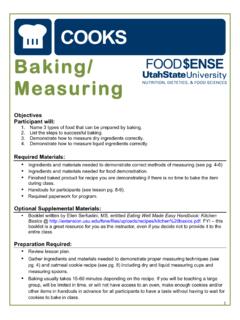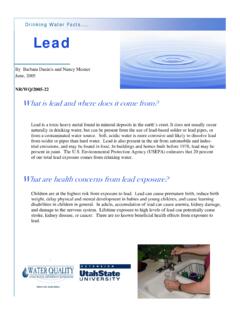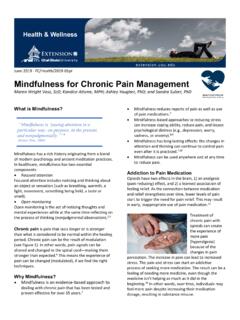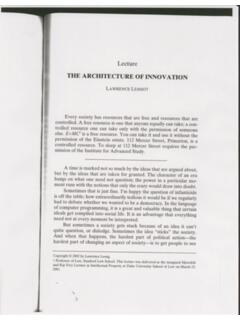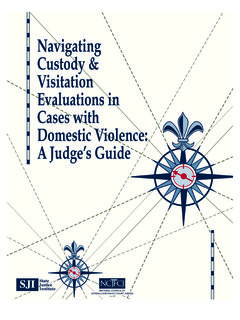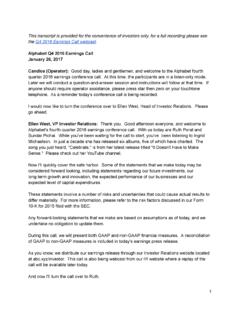Transcription of T O G E T H E R O U T D O O R R E C R E A T I O N E L E V ...
1 ELEVATING OUTDOOR RECREATION TOGETHER Opportunities for synergy between state offices of outdoor recreation andfederal land-management agencies, the outdoor recreation industry, non-governmental organizations, and local outdoor recreation providers Brooke Sausser Jordan W. Smith, Institute of Outdoor Recreation and Tourism at Utah State University This report is a joint research effort between the CONSERVATION AND OUTDOOR RECREATION DIVISION of the NATIONAL PARK SERVICE and the INSTITUTE OF OUTDOOR RECREATION AND TOURISM at UTAH STATE UNIVERSITY JULY 2018 Research conducted by BrookeSausser, a Master's student atUtah State University, underthe advisement of Dr.
2 JordanW. Smith, Director of theInstitute of OutdoorRecreation and Tourism This study was initiated andcommissioned by the Conservationand Outdoor Recreation Division ofthe National Park Service. Invaluableguidance, editing, and supportprovided by Bob Ratcliffe, KristaSherwood, and Adam Milnor. With special thanks to the interviewees, the Outdoor Industry Association, and the Center for Jackson Hole's SHIFT program for sharing information. This report is the first summary and analysis of the state offices ofoutdoor recreation. It provides a starting point for land managementagencies, state and local governments, industry, nonprofits, and otherpartners to better understand the origins and missions of newly-formedstate offices of outdoor recreation.
3 It also provides best practices forstates considering the establishment of their own office of outdoorrecreation, as well as recommendations to the current state offices andthe National Park Service to facilitate collaboration. Together, stateoffices and the stewards of their public lands can promote and enhancethe economic, social, and environmental benefits of outdoor recreation. EXECUTIVE SUMMARY Outdoor recreation is a major component of many local, state, and national economies, accounting for $887 billion inannual consumer spending and 2% of national gross domestic product. In addition to fueling many economies,outdoor recreation improves the quality of life for millions of individuals each year.
4 States across the country arebeginning to acknowledge the importance of outdoor recreation; more than eleven states in the last five years haveestablished formal offices or initiatives to promote the outdoor economy or other benefits of outdoor recreation. The purpose of this study is to provide an overview and analysis of the eleven current state offices or initiatives ofoutdoor recreation. As outdoor recreation relies on access to, and protection of, public lands, the study focuses onthe alignment of shared conservation and outdoor recreation goals with public land managers, specifically theNational Park Service.
5 However, the results will be relevant to other federal, state, and local land managemententities. The Institute of Outdoor Recreation at Utah State University, in partnership with the National Park Service,conducted 22 comprehensive interviews with the leadership, staff, or advocates of each state office of outdoorrecreation established by spring 2018. The interviews explored how and why the offices have emerged, what theyseek to accomplish, and how they collaborate with external entities. The goals of the interviews were to: 1)determine best practices for how state offices of outdoor recreation operate; and 2) identify opportunities for howthe state offices can partner with federal land management agencies, the outdoor recreation industry, non-governmental organizations, and local outdoor recreation providers.
6 State offices of outdoor recreation are customized to the needs and priorities of their states. The state offices varywidely in their organizational structures, locations within government, and mandates. Many offices are intentionallydesigned to cross boundaries among other functions of state government such as economic development, tourism,parks and recreation, and natural resources management, working as strategic coordinators or conveners to improvethe benefits of outdoor recreation to the economy, as well as conservation, health, and quality of life. Based on their approach to conservation, outdoor recreation, and economic development, state offices or initiativescan be classified into three categories: Industry FIRST, Industry AND, or Industry AFTER.
7 State offices categorized asIndustry FIRST prioritize economic development and see conservation as an inherent, although secondary offices categorized as Industry AND have adopted priorities balancing conservation, the outdoor economy, andother benefits of outdoor recreation. Finally, state offices categorized as Industry AFTER promote outdoor recreationfirst and foremost, with benefits to the economy seen as a beneficial byproduct rather than the principalgoal. Understanding where each office fits within this classification system can help NPS and other partners tailortheir approach to collaboration with the state offices.
8 BACKGROUND NEXT STEPS STUDY PURPOSE FINDINGS TABLE OF CONTENTS A New Era for Outdoor Recreation - 1 Study Purpose - 3 Research Approach - 4 Creating State Offices of Outdoor Recreation: The How and Why - 5 Instrumental Advocates - 6 Talking About the Outdoor Economy - 7 Elevating Outdoor Recreation State by State - 8 Goals and Programs of the State Offices of Outdoor Recreation - 10 At the Roots of Outdoor Recreation, Conservation, and Economic Development - 12 Comparing the Offices - 13 Elevating Outdoor Recreation Together - 14 Overcoming Internal Challenges - 15 Best Practices to Building an Office of Outdoor Recreation - 17 Partnerships.
9 Pain and Prosperity - 19 Future Opportunity - 22 A Nationwide Comparison of State Outdoor Recreation Initiatives [Chart] - 23 These national numbers quantify the impact ofrecreational pursuits by residents and tourists showcase an economy long underappreciated bystate governments. Backed by new economic data atthe national and state levels, and influenced byadditional state priorities, individual states havecreated unique offices to advocate for the outdoorrecreation industry and the benefits of conservationand outdoor recreation to communities. In 2013, Utah created the first Office of OutdoorRecreation. Five years later, more than ten stateshave followed suit, establishing temporary orpermanent offices, commissions, collaboratives, orpolicy positions, with additional states consideringthe idea.
10 All are based on the idea of strategicallyenhancing outdoor recreation to support economicgrowth and quality of life for their citizens, visitorsand communities alike. A NEW ERA FOR OUTDOOR RECREATION Outdoor recreation is the centerpieceof a newly recognized industry. $887,000,000 CONSUMER SPENDING $65,300,000 FEDERAL TAX REVENUE $7,600,000 JOBS 2% O u t d o o r I n d u s t r y A s s o c i a t i o n , 2 0 1 7 B u r e a u o f E c o n o m i c A n a l y s i s , 2 0 1 8 OF GDP According to the Outdoor Foundation, about 145million or half of all Americans participate in someform of outdoor recreation each year, whether it is aspart of an everyday close-to-home lifestyle or adestination vacation.
